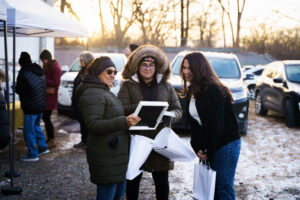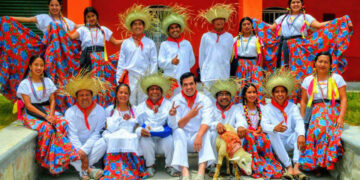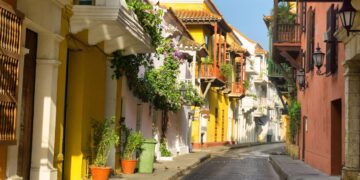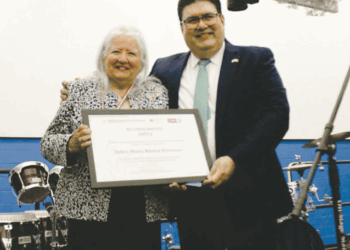On a chilly December afternoon, the walls of a once-forgotten building in Detroit came to life through photographic stories as families, friends, and passersby gathered to see the unveiling of I Am Because We Are, a mural that speaks to the heart of three interconnected communities.
Against the backdrop of 1800 18th Street, the former APAC building (located directly behind Michigan Central), the celebration echoed with laughter and shared memories as some sipped hot chocolate and warmed themselves by the fire while the spirit of Ubuntu. This philosophy reminds us that our humanity is tied to one another.

The I Am Because We Are mural is a testament to the resilience, diversity, and deep connection that define the Corktown, North Corktown, and Hubbard Richard neighborhoods. Inspired by the African philosophy of Ubuntu, which emphasizes humanity’s interconnectedness with the phrase “I am because we are,” the mural celebrates the shared strength and unity of these Detroit communities.
Designed by local artists Jessica Trevino and Romain Blanquart, the I Am Because We Are mural transforms the former APAC building into a striking tribute to the community. Spanning two sides of the giant structure with vibrant 10 x 23-foot banners, the artwork features 104 portraits of residents whose lives and stories capture the resilience and unity of Corktown, North Corktown, and Hubbard Richard. The installation, completed last week, set the stage for Saturday’s celebration, where neighbors gathered to honor their shared history and collective future in a moment of pride and connection.
“Part of this project is to say let’s celebrate the residents who have been here for generations, who are actually welcoming these changes. That can be a bit weary sometimes because change is scary,” Blanquart said.
“And so what do we do? We just want to make sure that people understand that nothing that you see here, that’s happening today and whether that’s being highlighted, would have been possible without long-time residents.”
Some familiar faces are on the walls, like Amelia Duran and son Gabe of Garage Cultural, and some are being introduced, like long-time residents of Corktown Mario Muscat. A disabled veteran, Muscat highlighted that he could not have imagined being a part of something like this but is glad he is because it’s helping him and his family be connected to the ‘new Corktown.’
“I used to know every single house, everybody in Corktown. When we were kids, we ran around the neighborhood and knew our neighbors,” Muscat said.
“Now that newer people are coming in, we are starting to get to know them. I see they’re starting to come out to say hi to the old-time residents, and that’s what makes this mural important.”
For the past year, the mural has been created collaboratively. The lead artists worked alongside two young interns, Julianna Izzard of Corktown and Lamar Dupree of Hubbard Richard, who received a grant from the Cultural Crossroads of Michigan among others.
The project also provided paid opportunities through the Community Foundation of Southeast Michigan for the interns to hone their artistic skills while actively contributing to a piece that celebrates their community. Their involvement highlights a commitment to empowering the next generation as caretakers of the neighborhood’s rich history and culture, ensuring its legacy thrives.
“What you see on the wall is a combination of multi-generational families and people who might have moved into the neighborhood in the last year, and so it was very important to be all-inclusive,” Blanquart said.
Artists Trevino and Blanquart describe I Am Because We Are as a heartfelt love letter to the neighborhoods they hold dear. Trevino, whose family has called Hubbard Richard home since 1962, has witnessed Detroit’s evolution through decades of continued change.
Blanquart, a French native who moved to Detroit in 2002, brings an outsider’s perspective shaped by two decades of immersion in the city’s culture. Their collaboration embodies the message of the mural: unity, diversity, and the power of community.

The title, I Am Because We Are, captures the ethos of Corktown, North Corktown, and Hubbard Richard, where stories of interconnectedness have been woven together over generations. These neighborhoods have faced challenges but have always risen with a shared sense of purpose and solidarity.
“The Ubuntu philosophy of Sub-Saharan Africa says that my existence and my well-being are only reflections of your well-being, and what I put into you will come to me,” Blanquart said.
“So, if I prosper, you prosper, we will all prosper. And so, we are interconnected, and if you take that at heart, really, that’s what makes a community function properly. It’s recognizing that we are all operating as human beings.”
The installation arrives at a pivotal moment for the area, with the recent full restoration and reopening of Michigan Central Station and developments continuously being added such as the Joe Louis Greenway. While these changes can be deemed scary, with gentrification taking place, the changes also signal hope and opportunity, they also spark concerns about preserving the original identities of the neighborhoods.
I Am Because We Are stands as a tribute to the people who have shaped Corktown, North Corktown, and Hubbard Richard, reminding the community of its rich history and the need to honor its roots while embracing new residents and opportunities.
The mural will remain on display for several months. Bedrock owns the building and there are currently no announced plans for it.
“We can only truly be ‘If I am, If you are, We are,’” Blanquart said.
“We wanted to get that message across and also just bring people together because even within the community, sometimes you realize not everybody knows each other. This is just another occasion to say, let’s talk to each other. Let’s engage in conversation.”
This story was made possible by the Race and Justice Reporting Initiative, which aims to build trust between the news media and Black, Indigenous, and People of Color communities and strengthen representative democracy. Funding for the initiative has been provided by a generous grant from Press Forward.
Unidos a través del arte: el mural "Yo Soy porque Nosotros Somos" celebra la resiliencia de tres históricos barrios de Detroit
En una fría tarde de diciembre, los muros de un edificio olvidado de Detroit han cobrado vida con fotografías históricas que hablan del corazón de tres comunidades interconectadas con el mural Yo Soy porque Nosotros Somos, mientras las familias, amigos y transeúntes se reúnen para disfrutar de la inauguración.
La celebración con el 1800 y la calle 18th de fondo en el antiguo edificio APAC (ubicado directamente detrás de Michigan Central), se llenó de risas y recuerdos, mientras se bebía chocolate y la gente se calentaba junto al fuego con el espíritu de Ubuntu, la filosofía que nos recuerda que nuestra humanidad está ligada a los demás.

El mural Yo Soy porque Nosotros Somos, es un testimonio de resiliencia, diversidad y profunda conexión entre los barrios de Corktown, North Corktown y Hubbard Richard; inspirado en la filosofía africana de Ubuntu, que enfatiza la interconexión de la humanidad con la frase “Yo Soy porque Nosotros Somos”, celebrando la fuerza compartida y la unidad de estas comunidades en Detroit.
Diseñado por los artistas locales Jessica Trevino y Romain Blanquart, el mural “Yo soy porque nosotros somos” transforma el antiguo edificio de APAC en un llamativo homenaje a la comunidad. La obra de arte, que abarca dos lados de la gigantesca estructura, con vibrantes pancartas de 3 x 7 metros, presenta 104 retratos de residentes, cuya vida e historia captura la resiliencia y la unidad de Corktown, North Corktown y Hubbard Richard. La instalación se llevó a cabo la semana pasada y preparó el escenario para la celebración del sábado, donde los vecinos se reunieron para honrar su historia y su futuro colectivo en un momento de orgullo y conexión.
“Parte de este proyecto es para decir que honremos a los residentes que han estado aquí durante generaciones y que realmente están dándole la bienvenida a los cambios, lo que puede resultar un poco agotador, porque el cambio nos da miedo”, dijo Blanquart.
“Entonces, ¿qué estamos haciendo? Solo queremos que la gente entienda que nada de lo que está sucediendo, hubiera sido posible sin los residentes que han estado aquí a lo largo del tiempo”.
Algunas caras conocidas están en los muros, como Amelia Duran y su hijo Gabe del Garage Cultural, y algunas están siendo presentadas, como Mario Muscat, residente de Corktown, que es un veterano discapacitado que destacó que nunca se hubiera imaginado ser parte de algo como esto, pero está contento de serlo porque lo está ayudando a él y a su familia a conectarse con el “nuevo Corktown”.
“Conocía todas las casas y a todos los de Corktown. Cuando éramos pequeños, corríamos por el vecindario y conocíamos a nuestros vecinos”, dijo Muscat.
“Ahora que ha llegado gente nueva, estamos empezando a conocerlos. Veo que están empezando a salir a saludar a los que tenemos mucho tiempo viviendo aquí, y eso es lo que hace que este mural sea importante”.
El año pasado se hizo el mural colectivamente. Los artistas trabajaron junto a dos jóvenes pasantes, Julianna Izzard de Corktown y Lamar Dupree de Hubbard Richard, recibiendo un financiamiento de Cultural Crossroads of Michigan y otras organizaciones.
El proyecto les ofreció una pasantía pagada a través de la Community Foundation of Southeast Michigan para que perfeccionaran sus habilidades artísticas mientras contribuían activamente en una pieza que celebra su comunidad. Su participación destaca el compromiso de empoderar a la próxima generación como cuidadores de la rica historia y cultura del vecindario, asegurando que su legado prospere.
“Lo que se ve en los muros es una combinación de familias multigeneracionales y personas que podrían haberse mudado al vecindario recientemente, por lo que era muy importante ser inclusivos”, dijo Blanquart.
Los artistas Trevino y Blanquart describen Yo Soy porque Nosotros Somos, como una carta de amor a las comunidades que aprecian. Trevino, cuya familia ha llamado a Hubbard Richard su hogar desde 1962, ha sido testigo de la evolución de Detroit a través de décadas de cambio.
Blanquart, un francés que se mudó a Detroit en 2002, aporta la perspectiva de un inmigrante, formado por dos décadas de inmersión en la cultura en la ciudad. Su colaboración encarna el mensaje del mural: unidad, diversidad y el poder de la comunidad.

El título, Yo Soy porque Nosotros Somos, captura el espíritu de Corktown, North Corktown y Hubbard Richard, donde las historias de interconexión se han tejido por generaciones, han enfrentado desafíos, pero siempre han resurgido con solidaridad.
“La filosofía Ubuntu del África subsahariana dice que mi existencia y mi bienestar son solo reflejos de tu bienestar, y lo que yo ponga en ti vendrá a mí”, comentó Blanquart.
“Por lo tanto, si yo prospero, tú prosperas, todos prosperaremos. Ya que estamos interconectados, y si tomas eso en serio, realmente, eso es lo que hace que una comunidad funcione correctamente. Es reconocer que todos estamos unidos como seres humanos”.
La instalación llega en un momento decisivo del área, con la completa restauración y reapertura de la estación central de Michigan y el continuo desarrollo que se avecina, como el Joe Louis Greenway. Si bien estos cambios pueden parecer aterradores, con la gentrificación en curso, son una señal de esperanza y oportunidad, pero que genera inquietud sobre la preservación de la identidade original de los vecindarios.
Yo Soy porque Nosotros Somos, es un homenaje a las personas que han dado forma a Corktown, North Corktown y Hubbard Richard, recordando a la comunidad, su rica historia y la necesidad de honrar sus raíces mientras acoge a nuevos residentes y oportunidades.
El mural permanecerá en exhibición durante varios meses, Bedrock es propietaria del edificio y actualmente no hay planes anunciados para él.
“Solo podemos ser verdaderamente ‘Si yo soy, si tú eres, nosotros somos'”, dijo Blanquart.
“Queríamos transmitir ese mensaje y también unir a la gente porque, incluso dentro de la comunidad, a veces te das cuenta de que no todo el mundo se conoce. Esta es otra ocasión para decir: hablemos y conversemos”.
Esta historia fue posible gracias a la Race and Justice Reporting Initiative, que tiene como objetivo generar confianza entre los medios de comunicación y las comunidades negras, indígenas y de color y fortalecer la democracia representativa. La financiación de la iniciativa ha sido proporcionada por una generosa subvención de Press.
Traducción Carmen Elena Luna














































